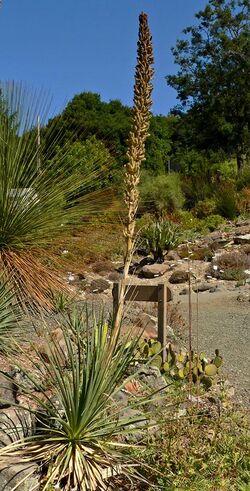Biology:Dasylirion durangense
| Dasylirion durangense | |
|---|---|

| |
| Scientific classification | |
| Kingdom: | Plantae |
| Clade: | Tracheophytes |
| Clade: | Angiosperms |
| Clade: | Monocots |
| Order: | Asparagales |
| Family: | Asparagaceae |
| Subfamily: | Nolinoideae |
| Genus: | Dasylirion |
| Species: | D. durangense
|
| Binomial name | |
| Dasylirion durangense Trel.
| |
| Synonyms[1] | |
| |
Dasylirion durangense, common name "sotol," is a perennial plant in the family Asparagaceae, native to Durango, Chihuahua and Sonora, Mexico. It is closely related to D. wheeleri S. Wats. and considered a variety of that species by some authors.[2] The plant has a large basal rosette of long stiff leaves over 1 m in length, bearing sharp, curved spines along the margins. The flowering stalk can be up to 3 m tall, bearing small wind-pollinated flowers.[3]
Some publications misspell the epithet as "duranguense" or "duranguensis." "Durangense" is correct.
Uses
The indigenous peoples of the Sierra Madre Occidental (Tarahumara, Pima Bajo, and Tepehuan) use the sweet immature flowering stalk to produce a distilled alcoholic beverage, also called sotol. They also strip the spines off the margins of the leaves and use the leaves to make baskets, holiday decorations and other items.[4][5][6]
References
- ↑ Tropicos Dasylirion durangense
- ↑ Laferrière, Joseph E. 1991. Dasylirion wheeleri var. durangense: a new combination in the Nolinaceae. Annals of the Missouri Botanical Garden 78(2):516-520.
- ↑ Trel., Proc. Amer. Philos. Soc. 50: 438. 1911.
- ↑ Pennington, C. W. 1963 The Tarahumar of Mexico: Their Material Culture. University of Utah Press, Salt Lake City.
- ↑ Pennington, C. W. 1969. The Tepehuan of Chihuahua: their material culture. University of Utah Press, Salt Lake City.
- ↑ Laferrière, Joseph E., & Willard Van Asdall. 1991. Plant use in Mountain Pima holiday decorations. Kiva 57:27-38.
Wikidata ☰ Q1172109 entry
 |

